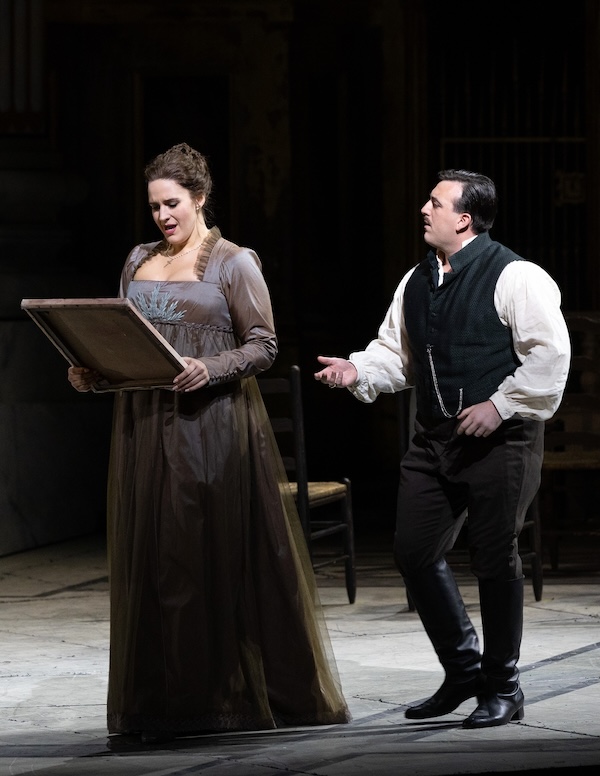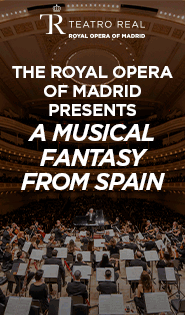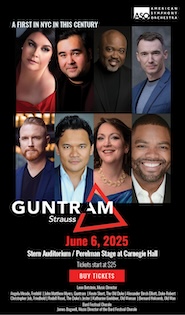A new cast still finding its footing in Met’s “Tosca”

Tosca is a mainstay of the Metropolitan Opera’s fall season with three cast changes and just as many conductors in David McVicar’s mostly conventional, if off-kilter production. The second cast—Lise Davidsen as Tosca, Freddie De Tommaso as Cavaradossi, and Quinn Kelsey as Scarpia—made its first appearance Tuesday evening with mixed results. There were memorable moments to be sure, but this run is clearly a work in progress.
The Met is commemorating the 100th anniversary of Puccini’s death on November 29, 1924 in a big way. Puccini’s operas were just as important for the company in the first decades of the 20th century as they are now. He was the only great European opera composer to have a close relationship with the company which he visited twice—to supervise the company premieres of Manon Lescaut and Madama Butterfly, and to oversee the 1910 world premiere of La Fanciulla del West.
Puccini’s presence is felt before you even enter the house, as his portrait looms large over the Lincoln Center Plaza. Inside, the Met has mounted “Puccini at the Met a Centenary Celebration,” an exhibit full of fascinating historical artifacts and memorabilia items drawn from its vast archives. A movie detailing Puccini’s relationship with the Met, as well as some fine historical photographs and film footage was shown before Tyesday’s performance.
Things got off to an exciting start as the three massive chords which open the opera resounded off the walls, under a clearly energized Yannick Nézet-Séguin. Patrick Carfizzi’s Sacristan seems to get ever louder and bolder, but remains great fun.
Things began to get a little rocky, however, with the entrance of De Tommaso, who was making his Met debut as Cavaradossi. (Coordination between pit and all three principal singers was an issue all night.) De Tommaso was in overdrive, barreling his way through “Recondita armonia,” at high volume but little dynamic or emotional nuance. Strangely, considering that De Tommaso and Davidsen—who was making her role debut as Tosca—regularly appear together, there was little chemistry between them.
Things looked up for De Tommaso in the second act, as his brash demeanor and decibel level suited Cavaradossi’s defiant stand against Quinn Kelsey’s Scarpia. The tenor’s shouts of “Vittoria! Vittoria! were truly triumphant. In the third act, De Tommaso sang a moving and well-modulated “E lucevan le stelle,” which was the best indicator of the entire evening of what all the fuss is about regarding this rising star.
For those looking for Italianate warmth and roundness in a voice, Davidsen will always disappoint. It is still an amazing instrument, however, and that alone made for a memorable Floria Tosca. The middle of her voice took a while to settle, but the top was free and clear from the start. With her every Met appearance, Davidsen’s singing emerges more refined, especially in the manner in which she deploys her glorious voice in terms of decibels.
Davidsen’s diva runs more towards imperial grandeur, rather than coy femininity. Although she was engagingly kittenish in her teasing, tender exchanges with De Tommaso in the first act. The soprano’s regal air yielded to defiance and fury as she went head to head with Kelsey’s Scarpia in Act II. The color of her voice was amazing as she commanded Kelsey’s Scarpia to die as he lay sprawled on the floor. “Vissi d’arte” emerged as a tender, solemn prayer with its emotions generated through long, supple phrases, enriched by the soprano’s subtle dynamic shadings.
Kelsey, who was making a role debut as Scarpia, had just finished his triumphant run as Rigoletto three evenings earlier. The malevolence and vocal beauty which the baritone brings to Verdi’s jester, transfers perfectly to Puccini’s heinous chief of police. He found his stride with conductor and orchestra much more readily than did either Davidsen or De Tommaso.
There is power to spare in Kelsey’s voice, which permitted it to ride easily over chorus and orchestra in the “Te Deum.” If Davidsen was at her best in Act II, it was because she had an equal sparring partner with whom to engage with Kelsey just pouring out the sound. Mere loudness, however, was not his objective, but rather instilling each measure with dramatic intensity.
The “Te Deum” is as good a test as any to gage a chorus’ power and flexibility. With Tilman Michael, the Met’s new chorus master, this fine ensemble seems to be in very capable hands.
Overenthusiasm aside, Nézet-Séguin knows his way around this score. Balance was never an issue, due in equal measure to the conductor’s artistic impulses and the size of the voices on stage.
The Met orchestra played splendidly, with no lapse of communication between orchestra and conductor. For all of the sonic grandeur, some of the most remarkable playing came in the opening measures of Act III with playing that was as luminous, as it was moving.
Tosca continues through January 23 with Sondra Radvanovsky, Brian Jagde, and Bryn Terfel taking over January 9 for the remainder of the performances. Xian Zhang conducts. metopera.org


